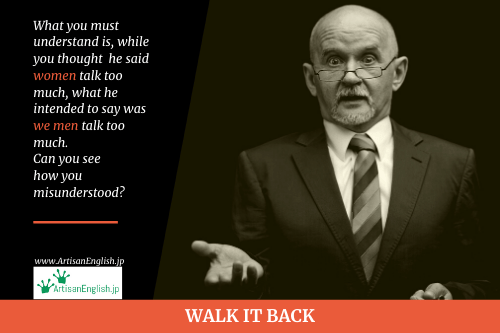
YouTube / iTunes / Spotify / Radio Public / Pocket Casts / Google Podcasts / Breaker / Overcast
Listen to ArtisanEnglish.jp posts & lesson intros here.
WotD: Walk it back
Estimated reading time: 2 minutes
I’ve never really paid attention to the legs of Japanese politicians, but I imagine they are muscular and as big as tree trunks.
Why? Well, every time a Japanese politician comments, they have to walk it back the next day.
When you walk something back, you try to take back, explain away, or reverse a comment or decision that you have made.
Fitness experts say walking backwards provides benefits for people.
I just did a quick Google search, and the first benefit is ‘sharpens the senses and mental clarity.’
I didn’t bother to read anymore because Japanese politicians have proved that one bogus.
Politicians, in general, walk things back so often that they should have a mind like a steel trap.
Yet they persist in saying stupid or idiotic things.
Like or follow ArtisanEnglish.jp on social media.
Didn’t one guy say women are baby machines, and another says the nuclear bombing of Hiroshima couldn’t have been helped?
Donald Trump’s spokespeople spent 50% of their time denying his gaffes and the other 50% of their time walking them back.
Yoshiro Mori recently said that women speak too much, but if he had listened to Fran Lebowitz, he would have been more than just a placeholder Prime Minister and would surely still be in his former position of JOC president.
It was Fran Lebowitz who said, ‘Think before you speak. Read before you think.’
It’s not my place to do this, but I’ll add to what she said.
‘Think before you speak. Read before you think. After that, if you still want to speak – DON’T.’
That way, you never have to walk anything back.
Flesch-Kincaid Readability Test
This post is understandable by someone with at least a 7th-grade education (age 12).
On the Flesch-Kincaid reading-ease test, this post scores 72.
The easier a passage is to read, the higher the score on a scale of 0 – 100.

